Module 1 Travel Unit 3 Language in use 教学课件(共84张PPT,无音频)
文档属性
| 名称 | Module 1 Travel Unit 3 Language in use 教学课件(共84张PPT,无音频) |  | |
| 格式 | ppt | ||
| 文件大小 | 1.5MB | ||
| 资源类型 | 教案 | ||
| 版本资源 | 外研版 | ||
| 科目 | 英语 | ||
| 更新时间 | 2021-03-05 22:24:46 | ||
图片预览

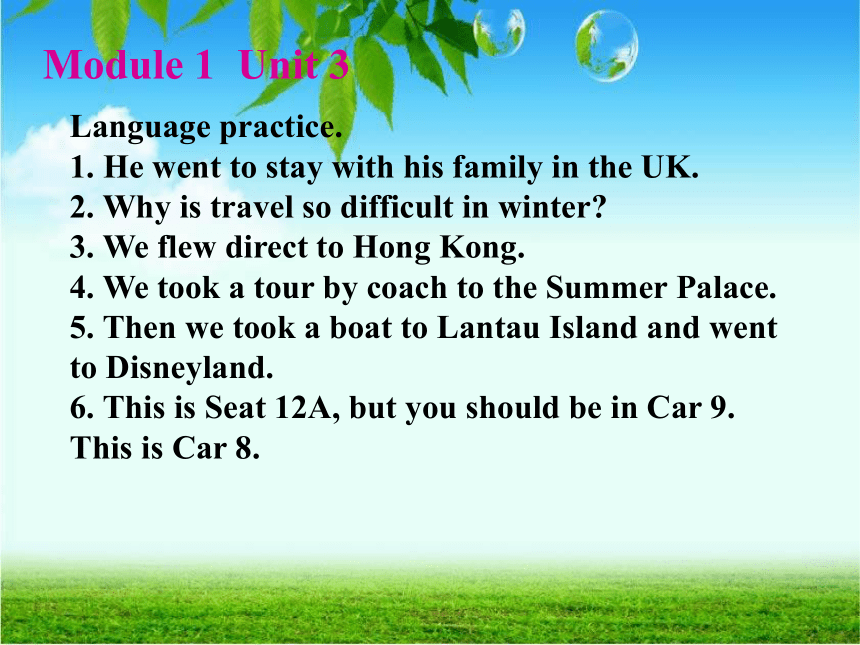
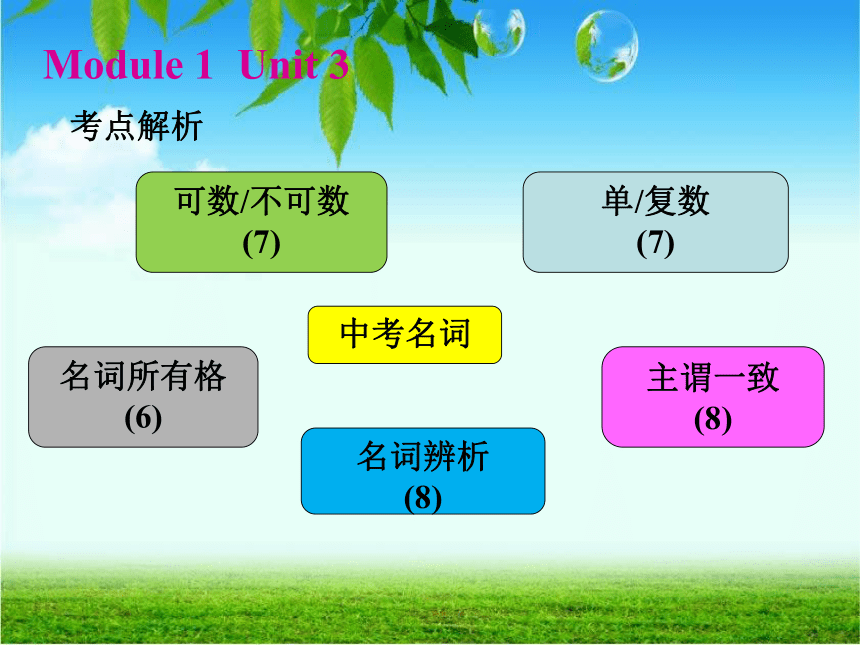
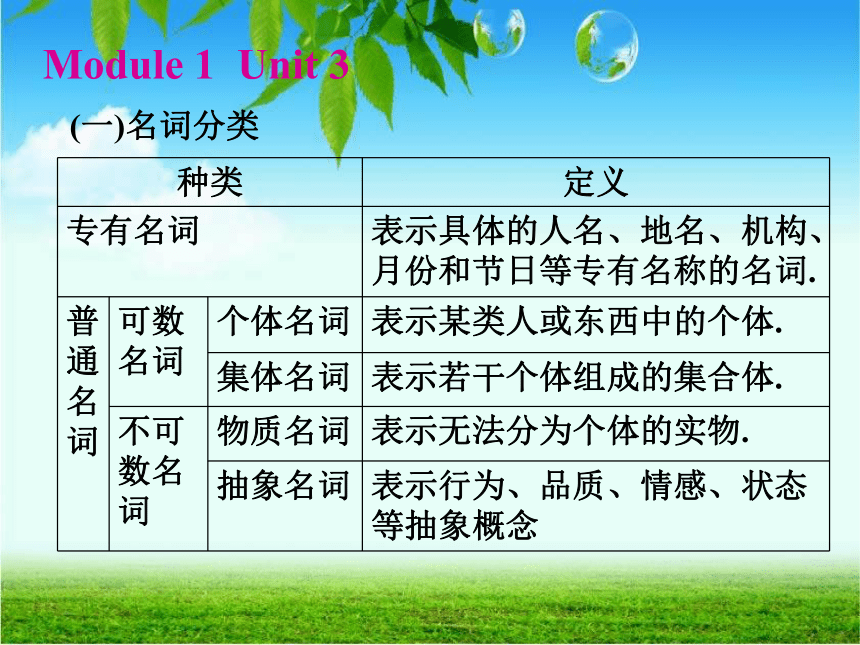
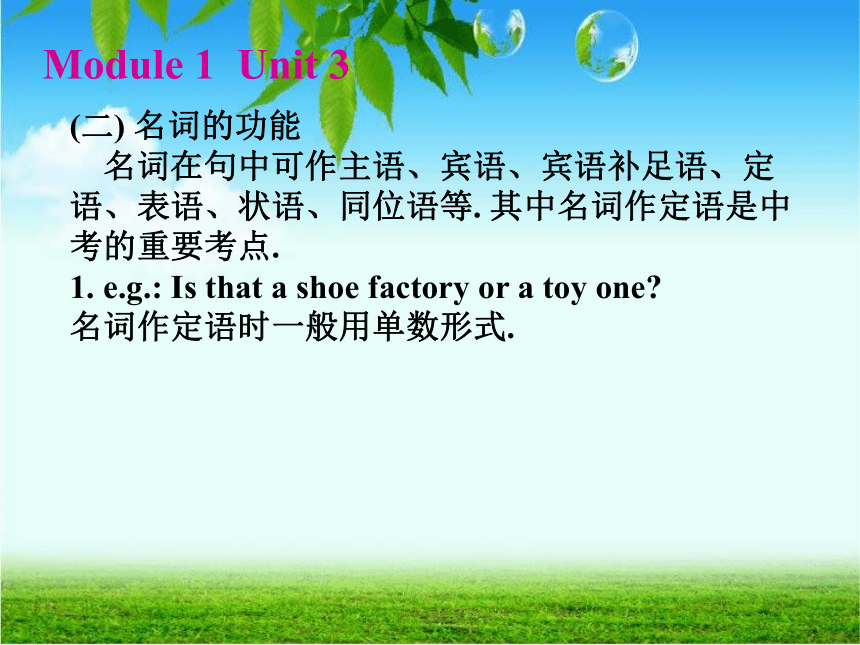
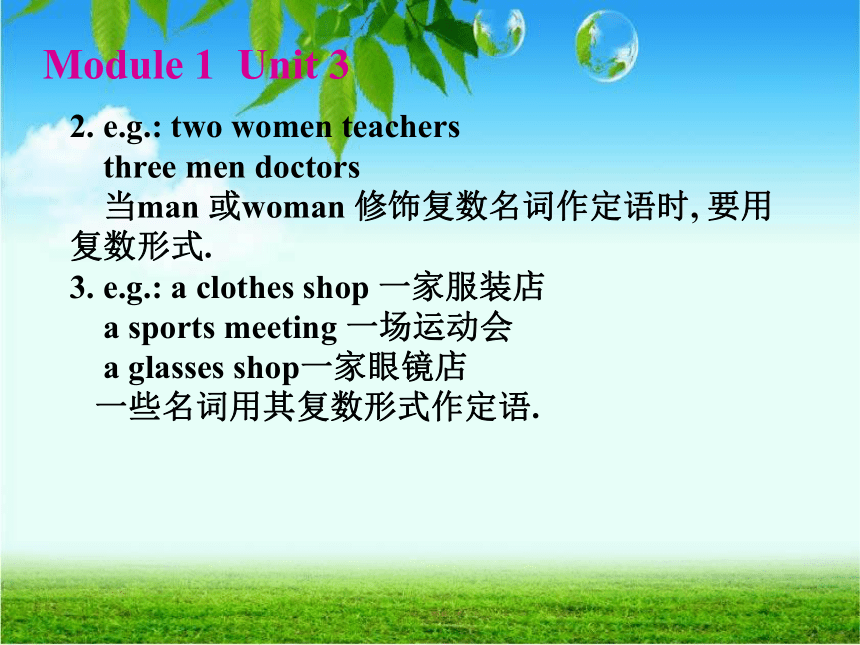
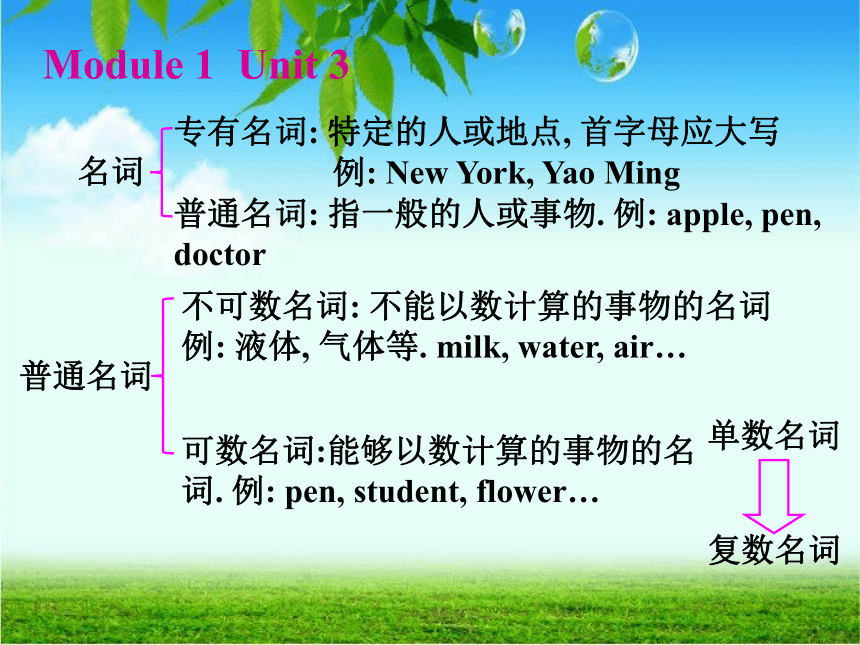
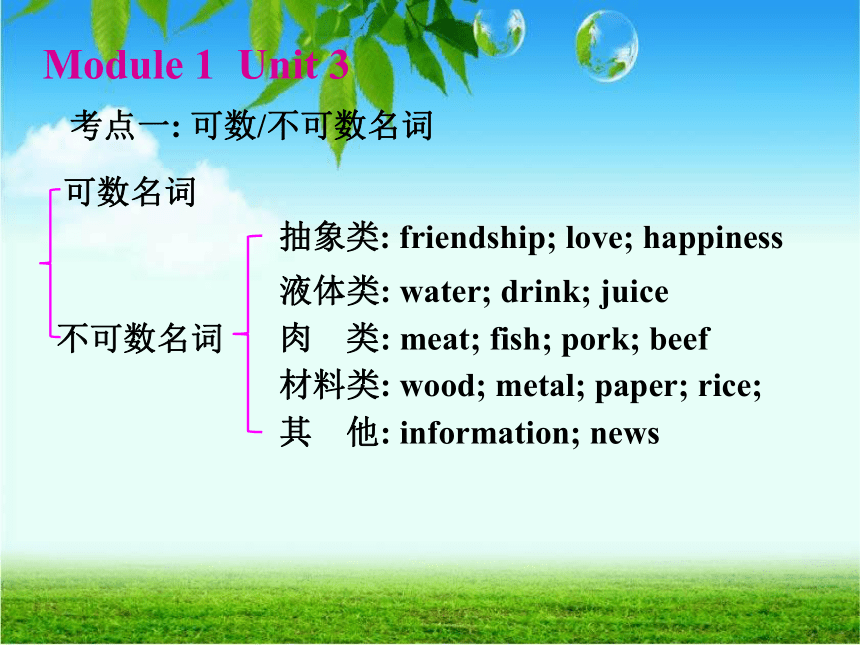
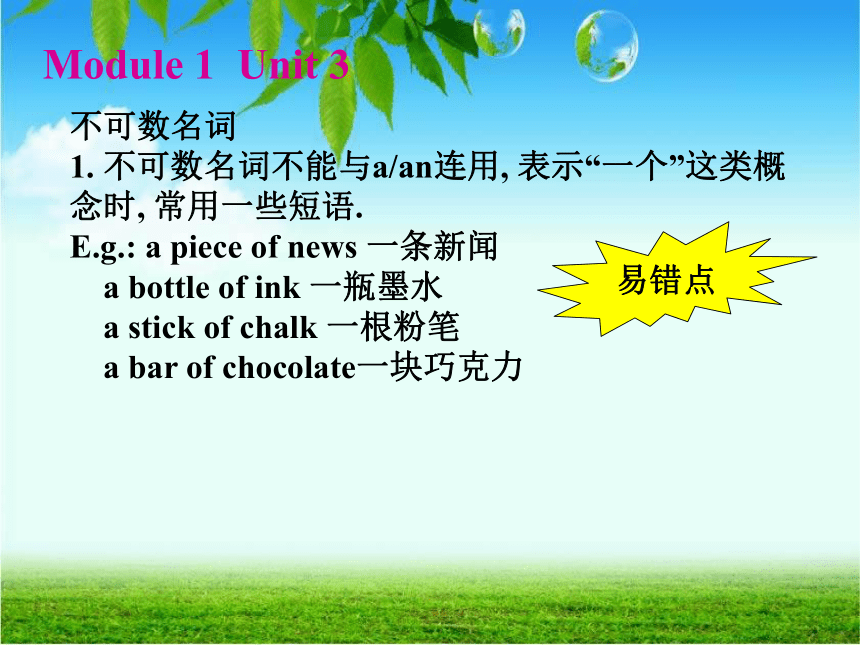
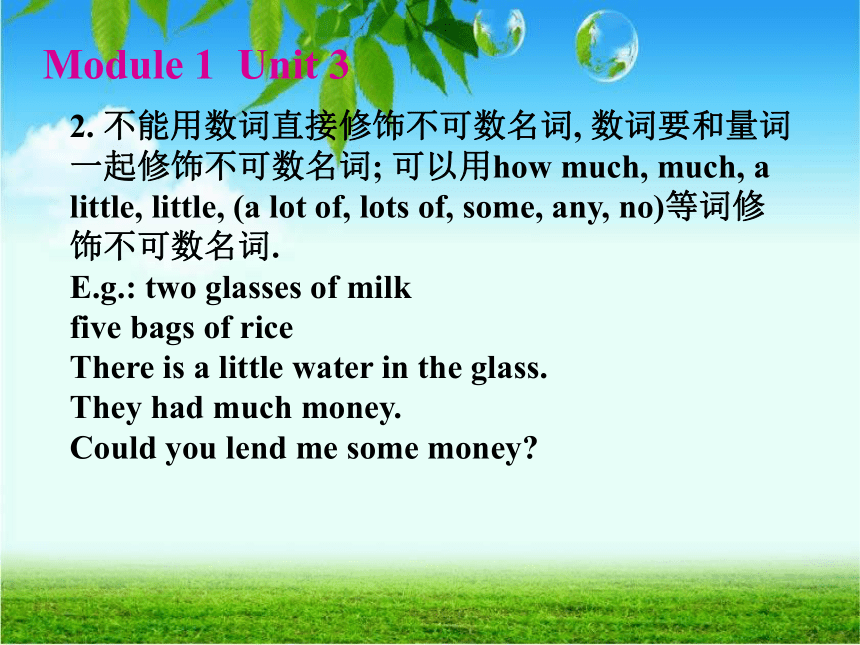
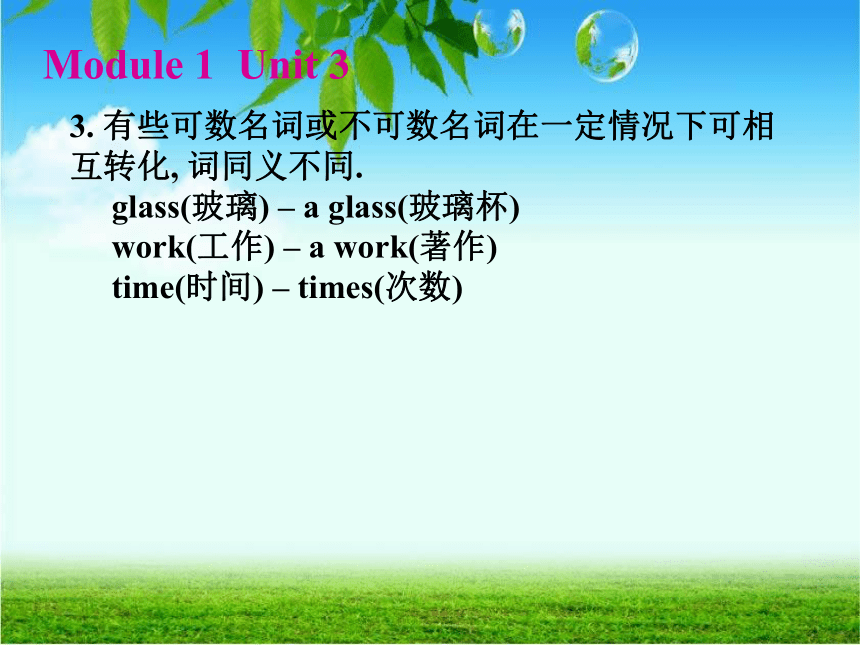
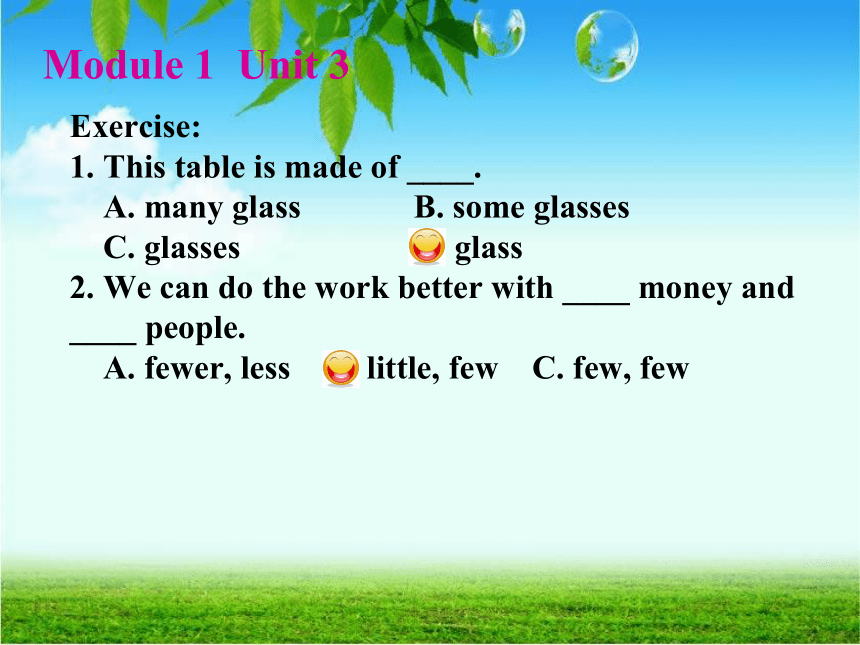
文档简介
Module 1
Travel
Unit 3
Language in use.
Writing and acting out a shot ply.
Language practice.
1. He went to stay with his family in the UK.
2. Why is travel so difficult in winter?
3. We flew direct to Hong Kong.
4. We took a tour by coach to the Summer Palace.
5. Then we took a boat to Lantau Island and went to Disneyland.
6. This is Seat 12A, but you should be in Car 9. This is Car 8.
Module 1 Unit 3
考点解析
中考名词
可数/不可数
(7)
单/复数
(7)
名词所有格
(6)
名词辨析
(8)
主谓一致
(8)
Module 1 Unit 3
种类
定义
专有名词
表示具体的人名、地名、机构、月份和节日等专有名称的名词.
普通名词
可数名词
个体名词
表示某类人或东西中的个体.
集体名词
表示若干个体组成的集合体.
不可数名词
物质名词
表示无法分为个体的实物.
抽象名词
表示行为、品质、情感、状态等抽象概念
(一)名词分类
Module 1 Unit 3
(二) 名词的功能
名词在句中可作主语、宾语、宾语补足语、定语、表语、状语、同位语等. 其中名词作定语是中考的重要考点.
1. e.g.: Is that a shoe factory or a toy one?
名词作定语时一般用单数形式.
Module 1 Unit 3
2. e.g.: two women teachers
three men doctors
当man 或woman 修饰复数名词作定语时, 要用复数形式.
3. e.g.: a clothes shop 一家服装店
a sports meeting 一场运动会
a glasses shop一家眼镜店
一些名词用其复数形式作定语.
Module 1 Unit 3
名词
专有名词: 特定的人或地点, 首字母应大写
例: New York, Yao Ming
普通名词
可数名词:能够以数计算的事物的名词. 例: pen, student, flower…
不可数名词: 不能以数计算的事物的名词
例: 液体, 气体等. milk, water, air…
单数名词
复数名词
普通名词: 指一般的人或事物. 例: apple, pen, doctor
Module 1 Unit 3
考点一: 可数/不可数名词
可数名词
不可数名词
抽象类: friendship; love; happiness
液体类: water; drink; juice
肉 类: meat; fish; pork; beef
材料类: wood; metal; paper; rice;
其 他: information; news
Module 1 Unit 3
不可数名词
1. 不可数名词不能与a/an连用, 表示“一个”这类概念时, 常用一些短语.
E.g.: a piece of news 一条新闻
a bottle of ink 一瓶墨水
a stick of chalk 一根粉笔
a bar of chocolate一块巧克力
易错点
Module 1 Unit 3
2. 不能用数词直接修饰不可数名词, 数词要和量词一起修饰不可数名词; 可以用how much, much, a little, little, (a lot of, lots of, some, any, no)等词修饰不可数名词.
E.g.: two glasses of milk
five bags of rice
There is a little water in the glass.
They had much money.
Could you lend me some money?
Module 1 Unit 3
3. 有些可数名词或不可数名词在一定情况下可相互转化, 词同义不同.
glass(玻璃) – a glass(玻璃杯)
work(工作) – a work(著作)
time(时间) – times(次数)
Module 1 Unit 3
Exercise:
1. This table is made of ____.
A. many glass B. some glasses
C. glasses D. glass
2. We can do the work better with ____ money and ____ people.
A. fewer, less B. little, few C. few, few
Module 1 Unit 3
名词单复数
规则变化
不规则变化
Module 1 Unit 3
考点二: 名词单复数
可数名词单数变复数的规则
(一) 规则变化
1. e.g.: map–maps, sea–seas, girl – girls, day–days,
desk–desks, book–books, pen – pens,
magazine – magazines, tree – trees
一般直接 + s.
若单词以清辅音结尾, 则s 发音为/s/.
若单词以元音或浊辅音结尾, 则s 发音为/z/.
Module 1 Unit 3
可数名词单数变复数的规则
2. e.g.: class – classes, bus – buses, glass – glasses,
box – boxes, bush – bushes, brush – brushes,
watch – watches, match – matches.
以s, x, sh, ch 结尾的单词, 在词尾加es.
es 读作/iz/.
Module 1 Unit 3
3. e.g.: baby–babies city–cities family–families party–parties story–stories country–countries.
以辅音字母加y 结尾, 变y 为i 再加es. es 读作/z/.
e.g.: boy–boys, key–keys, monkey–monkeys, holiday–holidays.
以元音字母加y 结尾, 直接加s. s 读作/z/.
Module 1 Unit 3
4. 以“辅音字母 + o” 结尾的名词变复数: 有生命加es, 无生命加s. es 和s 均读作/z/
常考有:
英雄: hero – heroes 土豆: potato – potatoes
西红柿: tomato – tomatoes
radio – radios piano – pianos photo – photos kilo – kilos
注: 以“元音字母 + o” 结尾的名词变复数均加s. 读作/z/.
e.g.: zoo – zoos kangaroo – kangaroos
Module 1 Unit 3
5. e.g.: half – halves, wolf – wolves, self – selves,
shelf – shelves, leaf – leaves, life – lives,
knife – knives, wife – wives, thief – thieves
部分以f/fe 结尾, 变f/fe 为v 再加es. ves 读作/vz/.
记忆口诀:
妻子(wife)自己(-self)看见戴着围巾(scarf)的小偷(thief)用刀(knife)割架子(shelf)上的一半(half)树叶(leaf)给狼(wolf)生活(life).
Module 1 Unit 3
(二) 不规则变化
1. e.g.: fish – fish sheep – sheep deer – deer
Japanese – Japanese Chinese – Chinese
单复数同形 (三种动物两国人)
2. e.g.: tooth – teeth foot – feet goose – geese
变oo为ee
3. e.g.: man – men, woman – women, policeman – policemen, Frenchman – Frenchmen,
Englishman – Englishmen
变man为 men
请区别: German(德国人) – Germans
("中日"不变"英法"变, 其余s加后面)
Module 1 Unit 3
4. 合成名词变复数
a. 将主体名词变为复数
sisters-in-law
b. 无主体名词时, 将最后一部分变为复数
boy classmates
c. 将两部分变为复数(仅woman, man作定语时)
women drivers
Module 1 Unit 3
(三) 有些名词只有复数形式.
people (人们) scissors(剪刀) trousers (裤子)
clothes (衣服) pants (长裤) shorts (短裤)
glasses (眼镜) socks(袜子) shoes(鞋子)
Module 1 Unit 3
Exercise.
1. Some ___ came to our school for a visit that day.
A. Germans B. Germen
C. Germany D. Germanies
2. In the picture there are many____ and two____.?
A. sheeps; knifes B. sheeps; knife
C. sheep; knives D. sheep; knife
Module 1 Unit 3
考点三: 名词所有格. “…的”
1. -’s 所有格及添加规则
1.1. 一般情况下, 在有生命的名词后加's.
e.g.: Linda's father, Lucy's book
1.2. 以s 结尾的词, 在s后加 ' 即可.
e.g.: teachers' office, the Jones' house
1.3. 不以s 结尾的复数词, 直接在词尾加’s.
e.g.: Children’s Day
…的
Module 1 Unit 3
2. -’s 所有格的特殊用法
2.1. 如果两个人共有同一物, 则只在后一个名词词尾加-’s;
e.g.: This is Tom and Peter's room.
这是汤姆和彼得的房间. (两个人共有)
如果两个人分别拥有某物, 则分别在两个名词词尾加-’s, 被修饰名词要用复数形式.
E.g.: These are Tom’s and Peter’s rooms.
这些是汤姆和彼得的房间. (分别拥有)
Module 1 Unit 3
2.2. 表示时间、距离、国家、地点和自然现象等无生命名词的所有格也可以用-’s的形式.
E.g.: today’s paper 今天的报纸
2.3. 表示店铺、医院、诊所、住宅等名称时, 名词所有格后面的这类名词常被省略.
E.g.: (1) I’m going to the doctor’s (office).
(2) She is staying at my uncle's (house).
Module 1 Unit 3
3. of 所有格
表示无生命的名词, 通常用“of +名词”的结构来表示所有关系. A’s B = B of A. “B的A.”
the windows of the room 房间的窗户
the cover of the dictionary 词典的封面
A’s B = B of A 作主语时, 谓语动词的数要与B 的数一致.
Module 1 Unit 3
4. 双重所有格的概念及用法
4.1. 表示部分概念, of 短语修饰的名词前通常有表示数量的限定词, 如a, an, one, two, some, several, a few, many, any, no等.
E.g.: This is a picture of mine. 这是我的一张照片.
4.2. 双重所有格与of 所有格的不同.
E.g.: (1) a photo of Mary’s 玛丽的一张照片
(玛丽许多照片中的一张, 不一定是她本人)
(2) a photo of Mary 一张玛丽的照片(玛丽本人的照片)
Module 1 Unit 3
4.3. e.g.: (1) A friend of Tom’s will join us in the game.
(2) Some friends of mine often help me with my English.
(3) I want a room of my own.
双重所有格的形式:
a. 名词 + of + 名词的 -’s 所有格
b. 名词 + of + 名词性物主代词
c. 名词 + of + one's own
Module 1 Unit 3
Practice
1. British people eat _____ a lot, and they are usually cooked in different ways.
A. chicken B. beef C. fish D. potatoes
2. — Do you like _____ ?
— No, I prefer rose, the color of your dress.
A. orange B. oranges C. carrot D. carrots
3. March 8th is _____ .
A. Woman’s Day B. Women Day
C. Woman Day’s D. Women's Day
Module 1 Unit 3
4. All the _____ teachers enjoyed themselves on March 8th, because it was their own holiday.
A. man B. men C. woman D. women
5. Of all the vegetables, I like _____ best.
A. potatoes B. eggs C. milk D. apples
6. June 1st is ____Day. All the Children enjoy it very much.
A. Children B. Childrens'
C. Children's D. Child
Module 1 Unit 3
7. These are _____ schoolbags.
A. Jim and Tom’ B. Jim’s and Tom
C. Jim and Tom D. Jim’s and Tom’s
8. Last Sunday I met _____ in the supermarket.
A. a friend of Jim B. a friend of Jims
C. a friend of Jims’ D. a friend of Jim's
Module 1 Unit 3
考点四: 主谓一致
1. 单个的不可数名词作主语时谓语动词用单数
e.g.: Some bread is over there.
2. 常以复数形式出现的名词作主语, 谓语用复数.
e.g.: shoes, trousers, socks, glasses
My clothes are newer than yours.
Module 1 Unit 3
3. 集体名词通常用作复数, 谓语用复数 police, cattle, family, people, group, team, class
(不分男女).
对比下边两组题, 用be填空.
My family ____ having dinner.
My family ____ a happy one.
The police ____ running after the thief.
The policeman ____ running after the thief.
are
is
are
is
Module 1 Unit 3
Exercise
1. Last night, there was an accident. Ten _____ were hurt, but no _____ were lost.
A. child; lives B. children; lives
C. children; life D. child; life
2. The two bedrooms are the ____.
A. twins B. twin's C. twins' D. twins
3. Our hospital needs two ___ doctors, Mrs. Li. You can ask your son to have a try.
A. women B. man C. woman D. men
Module 1 Unit 3
4. The police ___ on the street when accident happened.
A. is B. are C. was D. were
5. — Where is Tom? — He has gone to the _____.
A. teacher B. teachers
C. teacher's D. teachers’
6. This pair of shorts ___ too expensive. I can't afford____.
A. are, them B. are, it
C. is, them D. is, it
Module 1 Unit 3
冠词
1. 冠词的定义
2. 定冠词的用法
3. 不定冠词的用法
4. 零冠词的用法
Module 1 Unit 3
1. 冠词的定义
冠词是一种虚词, 没有词义, 没有数和格的变化, 不能单独使用, 只能帮助名词或起名词作用的其他词类说明其意义.
冠词分定冠词和不定冠词两大类:
定冠词特指一特定名词
不定冠词泛指一般普通名词.
Module 1 Unit 3
2. 定冠词 the 的用法:
2.1. e.g.: The book is mine.
指特定的人或物, 用于特指的名词前.
2.2. e.g.: (1) I heard a report. The report was about war.
(2) Please close the window before you fall asleep.
表示上文提到的或说话双方都知道的人或物.
2.3. e.g.: The moon goes round the earth.
世界上独一无二的事物前常用the.
Module 1 Unit 3
2.4. E.g.: (1) Our classroom is on the second floor.
(2) It's the most interesting book I have read.
(3) I have two sisters. The elder one is a doctor.
用于序数词、形容词最高级以及对两者进行比较时起特定作用的比较级前.
2.5. e.g.: the Greens 格林一家人或格林夫妇.
在姓的复数形式前加the, 表示一家人或夫妇二人.
2.6. E.g.: the rich, the poor, the old
用于某些形容词前表示一类人或事物.
Module 1 Unit 3
2.7. E.g.: the Changjiang River, the Great Wall, the Summer Palace
用于江河、山脉、湖泊、岛屿、杂志和报纸等专有名词前.
2.8. e.g.: the United States
用于由普通名词构成的专有名词前.
2.9. e.g.: play the piano / violin
用于西洋乐器名称前.
2.10. 用于固定短语中.
e.g.: at the moment, by the way, in the middle of
Module 1 Unit 3
3. 不定冠词 a / an的用法:
3.1. e.g.: a book, a table, an elephant, an orange
a 用在以辅音开头的单词前, an 用在以元音开头的单词前.
3.2. e.g.: The little girl played a whole day outside.
表示数量“一”, 意思与“one”接近, 但数的概念没有one强.
3.3. A teacher from England will teach us English.
用于首次提到的某人或某物前, 表泛指.
3.4. E.g.: A tiger is very dangerous.
用于可数名词的单数前, 表示一类人或物.
Module 1 Unit 3
3.5. e.g.: He is a ball player.
表示某类人或事物当中的任何一个, 相当于one. 泛指人或事物的类别.
3.6. e.g.: A Mr. Wang is waiting for you.
表示 "某一" .
3.7. e.g.: (1) He earns two thousand yuan a month.
(2) You should take this medicine three times a day.
(3) The train is running sixty miles an hour.
表示"每一个", 相当于every, per. 用在表示时间, 速度, 价格, 重量, 长度等单位前.
Module 1 Unit 3
3.8. e.g.: (1) They have a second house.
(2) When I sat down, a fifth man rose to speak.
序数词前, 一般有定冠词, 但当表示"又一个"时, 则要用不定冠词.
3.9. e.g.: (1) Green tea is a wonderful tea.
(2) She is a beauty.
(3) Please give me a coffee.
不可数名词前用a 或an表示具体意义、制成品或种类.
Module 1 Unit 3
3.10. e.g.: (1) We hope we can see a full moon tonight.
(2) He sat in a chair, looking at a starry sky.
有些世界上独一无二的东西, 如sun, moon, sky, universe(宇宙), world(世间, 地球), earth (地球)等, 一般前面要用定冠词.
但当他们前面有修饰语时, 则要用不定冠词.
3.11. e.g.: (1) We had a wonderful lunch.
(2) We had a very cold winter last year.
季节、月份、日期、三餐前有修饰语时, 用不定冠词.
Module 1 Unit 3
3.12. 用在某些固定的短语中
e.g.: once upon a time, in a hurry
have a rest, have a good time
have a look, all of a sudden
have a cold/fever/cough/headache/pain
Module 1 Unit 3
4. 零冠词的用法
一般来说, 在一个句子中有时名词前不加冠词, 这种不加冠词的现象, 就叫“零冠词”.
4.1. e.g.: (1) Horses are useful animals.
(2) There are pens and books on the desk.
复数可数名词前, 表示人或物的类别, 或泛指不定量的人或物.
4.2. e.g.: (1) She is our math teacher.
(2) The man in blue is Mary's father.
(3) No one can get this book.
当名词前有物主代词、指示代词、不定代词及名词所有格等修饰时.
Module 1 Unit 3
4.3. e.g.: by boat, on foot. I like math.
交通工具、学科名词前.
4.4. E.g.: (1) He prefers to play football.
(2) The two old men are playing chess.
(3) Can you speak English?
球类运动、棋类游戏及语言名称前.
4.5. e.g.: (1) in spring, on Monday
(2) Children's Day is coming.
(3) I ate some noodles for lunch.
季节、月份、星期、节日、三餐等名词前.
4.6.某些固定搭配的词组.
in public; go to bed
Module 1 Unit 3
Complete the sentences with proper articles.
1. There is _____ American boy in our class and _____ boy can speak Chinese well.
2. _____ old man behind Mary is _____ university teacher.
3. Don't talk to Simon like that. He is just _____ eleven-year-old boy.
4. I really like _____ book you lent me yesterday.
5. _____ Greens are preparing for the coming Thanksgiving Day.
6. Eric is not going to Nanjing by _____ plane. Instead, he is taking _____ train.
Module 1 Unit 3
an
the
The
a
an
the
The
/
a
7. Mr Green needs to take a week off. His mother is ill in _____ hospital.
8. In 1969, American pilots made _____ second trip to the moon.
9. Mary is good at playing _____ piano, and her little brother Jim is good at playing _____ baseball.
10. Yesterday was my grandfather's _____ seventieth birthday.
11. They always have ____ bread for _____ dinner.
12. On _____ Sunday, they often play _____ soccer.
13. He told me that _____ book on _____ desk was _____ English book.
Module 1 Unit 3
/
a
the
/
/
/
/
/
/
the
the
an
数词
1. 数词的类别:
1.1. 基数词 表数量
1.2. 序数词 表顺序
Module 1 Unit 3
2. 基数词的构成:
2.1. 1~12, 独立成词.
one two three four five six seven
eight nine ten eleven twelve
2.2. 13~19, 由3~9 + -teen构成.
14 — fourteen 16 — sixteen
17 — seventeen 19 — nineteen
特殊拼写:
13 — thirteen 15 — fifteen 18 — eighteen
Module 1 Unit 3
2.3. 20~90, 以-ty 结尾.
20 — twenty 30 — thirty
40 — forty 50 — fifty
60 — sixty 70 — seventy
80 — eighty 90 — ninety
2.4. 21~99, 两位数, 十位与个位之间加连字符“-".
21 twenty-one 55 fifty-five
99 ninety-nine
Module 1 Unit 3
3. 数字表达法: 1234567890
中 英
数字: 1 2 3 4 5 6 7 8 9 0 数字: 1 2 3 4 5 6 7 8 9 0
,
亿
万
,
,
billion
million
thousand
3.1. 确定各段单位
3.2. 各单位前的最多3个数字, 按照“百十个” 位的读法进行翻译. e.g. 1, 234, 567, 890
billion,
million,
thousand,
One
two hundred and thirty-four
five hundred and sixty-seven
eight hundred and ninety
Module 1 Unit 3
4. 数字中必须用and 的情况:
4.1. 百位与十位之间, 百位与个位之间(十位为零).
E.g.: 121; 101
one hundred and twenty-two, one hundred and one.
4.2. 千位与十位之间(百位为零), 千位与个位之间(百位和十位均为零).
e.g.: 2016:
3003:
two thousand and sixteen
three thousand and three
Module 1 Unit 3
Practice
150, 000:
500, 000:
2, 100, 000:
5, 600, 000:
82, 550, 000:
200, 030, 040:
one hundred and fifty thousand.
five hundred thousand.
two million, one hundred thousand.
five million, six hundred thousand.
eighty-two million, five hundred and fifty thousand.
two hundred million, and thirty thousand, and forty.
Module 1 Unit 3
5. 小数的读法
5.1. 小数点译为point;
5.2. 小数点后的数字挨个读出即可.
e.g.: 5.34
1.22
5.3. 若整数部分为零, 以point 开头进行朗读即可,
e.g.: 0.23
0.788
5.4. e.g.: 0.23 kilo; 2.31 kilos
0.999 hour; 1.001 hours
小数若等于或小于1, 小数后的名词用单数;
小数若大于1, 小数后的名词用复数.
five point three four
one point two two
point seven eight eight
point two three
Module 1 Unit 3
6. 分数读法&用法
e.g.: That's almost one fifth of the world's population, …
6.1. one fifth 五分之一 fifth 是序数词.
分数的表达: 分子用基数词, 分母用序数词.
e.g.: 1/8: 1/2:
1/4:
6.2. 当分子大于1 时, 该怎么办呢?
2/5: two fifths 3/8:
分子大于1时, 分母 + s.
e.g.: 2/3: 5/12:
3/4:
a half
two thirds
one eighth
three eighths
five twelfths
three fourths
= three quarters
one fourth
= a/one quarter
Module 1 Unit 3
6.3. Two thirds of the students have passed the exam.
分数作主语时, 谓语的数同of 后的名词的数保持一致.
Module 1 Unit 3
7. 基数词的用法:
7.1. e.g.: (1) Our country has a population of 1, 300 million people.
(2) After the war, thousands of people became homeless.
表示具体数目, hundred, thousand, million 不用复数.
表示不确定数目, 用复数. 即hundreds of(数百), thousands of(数千), millions of(数百万)+ 名词复数, 可以用many/several修饰, 但不能与具体数目连用.
Module 1 Unit 3
7.2. e.g.: (1) He died in his forties.
(2) In the nineties, most people go to work by bike.
(3) It describe the social live in the 1960s.
"几十" 的复数形式可以表示:
几十多岁 — in + one’s + 数词复数
年代 — in + the +数词复数
7.3. a 3-year-old girl a seven-day holiday
构成合成形容词:
基数词 - sl (-adj) 在句中只能作定语
Module 1 Unit 3
7.4. e.g.: The classroom is 7 meters long, 6 meters wide and 3 meters high.
表计量: 基数词 + 度量单位复数 + adj
在句中只能做表语
7.5. 表示时刻 (介词用at)
7.5.1. 顺读法—先时后分, “几点几分”
9:30 nine thirty
6:21 six twenty-one
Module 1 Unit 3
7.5.2. 逆读法—先分后时
a. 表示“几点过几分”, 半小时以内, 介词用past, 分钟数 + past + 钟点数.
10:10 ten past ten
8:20 twenty past eight
7.5.3. 表示“几点差几分”, 半小时以上, 介词用 to, 60减原分钟+ to + (下一个)钟点数.
9:50 ten to ten
7:40 twenty to eight
Ext.: 15分钟: a quarter 30分钟: a half
9:15 a quarter past nine
12:30 half past twelve
Module 1 Unit 3
8. 序数词的变化规则:
1:
2:
3:
4:
5:
6:
7:
8:
9:
10:
1st:
2nd:
3rd:
4th:
5th:
6th:
7th:
8th:
9th:
10th:
first
second
third
fourth
fifth
sixth
seventh
eighth
ninth
tenth
one
two
three
four
five
six
seven
eight
nine
ten
Module 1 Unit 3
11:
12:
13:
14:
15:
16:
17:
18:
19:
20:
21:
22:
eleventh
twelfth
thirteenth
fourteenth
fifteenth
sixteenth
seventeenth
eighteenth
nineteenth
twentieth
twenty-first
twenty-second
11th:
12th:
13th:
14th:
15th:
16th:
17th:
18th:
19th:
20th:
21st:
22nd:
eleven
twelve
thirteen
fourteen
fifteen
sixteen
seventeen
eighteen
nineteen
twenty
twenty-one
twenty-two
Module 1 Unit 3
30:
40:
50:
60:
70:
80:
90:
thirty
forty
fifty
sixty
seventy
eighty
ninety
30th:
40th:
50th:
60th:
70th:
80th:
90th:
thirtieth
fortieth
fiftieth
sixtieth
seventieth
eightieth
ninetieth
基数词变序数词规则:
1, 2, 3 全变, 其余th 加后面;
八(eight) 去t, 九(nine) 去e, 以y 结尾变ie;
five, twelve 两兄弟, ve 要用fth;
遇到几十几, 只变个位就可以.
Module 1 Unit 3
9. 序数词的用法
9.1. e.g.: (1) The second bus is coming.
(2) Today is Lucy’s ninth birthday.
表顺序, 前面通常要加定冠词the.
但如果序数词前已有-’s所有格、指示代词、形容词性物主代词时则不加the.
9.2. e.g.: I've tried twice, but I'll try a third time.
序数词前加不定冠词a(an)
意为"再…; 又…".
Module 1 Unit 3
9.3. e.g.: 10th September = Sept. 10th
表示日期中的"日". 读的时候要加the.
10th September: the 10th of September
September 10th: September the 10th
9.4. 日期表达法.
① 1st October, 2020
② 4th July, 2020
③the tenth of September
④ September 10th, 2020
在英语的日期表达中, 其顺序一般是 _________, 表示某日一般使用 __________ 词.
日月年
月日年
序数
Module 1 Unit 3
10. 数词的句法作用:
e.g.: (1) Five and two is seven.
做主语
(2) She has eaten two eggs and I have eaten three.
作宾语
(3) We have three meals every day.
做定语
(4) First, open your exercise book; second, write down the new words.
做状语
Module 1 Unit 3
Activity 1. Complete the conversation with a, an, the or zero article where necessary.
A: I'm really looking forward to (1)_____ summer holiday. We're taking (2)______ trip to (3)______ Paris!
B: How wonderful! It's (4)______ interesting and beautiful city. How long will (5)_____ flight take?
A: The flight takes about (6)_____ hour. When we arrive, we will get to our hotel by (7)_____ bus. (8)_____ hotel is right in (9)_____ centre of (10)______ city, so we can visit all the famous places.
Module 1 Unit 3
the
a
/
an
the
an
/
The
the
the
B: Are you planning to visit (11)______ Louvre Museum?
A: Yes, we are.
Module 1 Unit 3
/
Activity 2. Underline the correct words.
1. Children have to go to school / the school when they are six years old.
2. I'm a teacher at school / the school on the corner.
3. He's got a lovely garden. Flowers / The flowers in it are really beautiful.
4. Make sure you get to the airport in time / in the time for your plane.
5. — How many CDs have you got?
— Only few / a few.
6. That's most / the most interesting news I've heard for a long time.
7. How long have Whites / the Whites lived here?
Module 1 Unit 3
Activity 3. Complete the sentences with the words in the box.
1. She had an important meeting that afternoon, so she had to take an earlier _______.
2. Please take your ________.
3. Sam went with Jane to the railway ________ to see her off.
4. It is wonderful to _______ the streets of the city.
5. Flight KA846 from Hong Kong _______ five minutes ago.
6. “Please have your tickets ______,” said the ticket officer.
Module 1 Unit 3
fight
seat
station
tour
landed
ready
Activity 4. Complete the sentences with the expressions in the box.
1. They will not arrive on time ________________ the bad weather.
2. Everyone in China is __________________ seeing their family members during the Spring Festival.
3. Lie down on your bed and ________________.
4. The journey was _______________ exciting experiences.
5. ____________ you can come by six, I will be here.
Module 1 Unit 3
because of
looking forward to
make yourself comfortable
full of
As long as
Activity 5. Listen and complete the notes.
London to Sydney
London – Hong Kong: ________ hour(s)
Hong Kong - Sydney: ________ hour(s)
From airport to centre of Hong Kong: ________ hour(s)
Price of flight: £________
Price of flight and hotel: £________
Module 1 Unit 3
12
9
1
1199
1247
Sydney to London
Sydney – London: ________ hour(s)
Price of flight: £________
Price of flight and hotel near airport: £________
From airport to centre of Sydney: _____ kilometers
Module 1 Unit 3
24
1119
17
20
Activity 6. Work in pairs. Look at the notes you have made in Activity 5. Talk about:
● Which flight takes a longer time?
● Which is more expensive?
Module 1 Unit 3
Activity 7. Read the passage and complete the table.
Module 1 Unit 3
Advantage of Concorde
Disadvantage of Concorde
● fast speed ● short time
of journey
● noisy
● bad for the
environment
● hurt people's ears
Activity 8. Read the passage again and answer the questions.
1. How many passengers could Concorde carry?
It could carry one hundred passengers.
2. Why do many people think Concorde was one of the greatest planes?
Because it flew faster than the speed of sound.
3. How many hours did Concorde take to fly from London or Pairs to New York?
It took people from London or Pairs to New York in just over three hours.
Module 1 Unit 3
Activity 9. Work in pairs. Talk about your recent travel experience. Say:
● how you travelled
● how long the journey took
● how you felt about it
Now write a passage about your experience.
Module 1 Unit 3
Around the world.
Module 1 Unit 3
Read the passage and answer the questions:
1. Who was the first pilot to fly alone across the Atlantic Ocean?
Charles Lindbergh was the first pilot to fly alone across the Atlantic Ocean.
2. When was his plane completed?
It was completed in April, 1927.
3. What was the plane like?
It was three meters high and weighed 975 kilos.
4. Where did he take off in May 1927?
He took off from New York.
5. How long did he fly?
He flew for about thirty-three hours.
Module 1 Unit 3
Module 1 Unit 3
查尔斯·奥古斯都·林德伯格(Charles Augustus Lindbergh, 又译林白, 1902年2月4日-1974年8月26日)是一位著名美国飞行员、作家、发明家、探险家与社会活动家.
他于1927年驾驶单引擎飞机Spirit of St. Louis, 从纽约市罗斯福飞行场横跨大西洋飞至巴黎巴黎-勒布尔热机场, 成为历史上首位成功完成单人不着陆飞行横跨大西洋的人, 并因此获赠荣誉勋章. 美国圣地亚哥林德伯格国际机场即以他的名字命名.
Activity 10. Work in groups. Find a news story about a good deep and turn it into a short play. Decide:
●the characters
●the place and time
●the plot
Now write the play.
Module 1 Unit 3
Activity 11. Decide who will play each character.
Activity 12. Act out the play to the whole class.
Module 1 Unit 3
Travel
Unit 3
Language in use.
Writing and acting out a shot ply.
Language practice.
1. He went to stay with his family in the UK.
2. Why is travel so difficult in winter?
3. We flew direct to Hong Kong.
4. We took a tour by coach to the Summer Palace.
5. Then we took a boat to Lantau Island and went to Disneyland.
6. This is Seat 12A, but you should be in Car 9. This is Car 8.
Module 1 Unit 3
考点解析
中考名词
可数/不可数
(7)
单/复数
(7)
名词所有格
(6)
名词辨析
(8)
主谓一致
(8)
Module 1 Unit 3
种类
定义
专有名词
表示具体的人名、地名、机构、月份和节日等专有名称的名词.
普通名词
可数名词
个体名词
表示某类人或东西中的个体.
集体名词
表示若干个体组成的集合体.
不可数名词
物质名词
表示无法分为个体的实物.
抽象名词
表示行为、品质、情感、状态等抽象概念
(一)名词分类
Module 1 Unit 3
(二) 名词的功能
名词在句中可作主语、宾语、宾语补足语、定语、表语、状语、同位语等. 其中名词作定语是中考的重要考点.
1. e.g.: Is that a shoe factory or a toy one?
名词作定语时一般用单数形式.
Module 1 Unit 3
2. e.g.: two women teachers
three men doctors
当man 或woman 修饰复数名词作定语时, 要用复数形式.
3. e.g.: a clothes shop 一家服装店
a sports meeting 一场运动会
a glasses shop一家眼镜店
一些名词用其复数形式作定语.
Module 1 Unit 3
名词
专有名词: 特定的人或地点, 首字母应大写
例: New York, Yao Ming
普通名词
可数名词:能够以数计算的事物的名词. 例: pen, student, flower…
不可数名词: 不能以数计算的事物的名词
例: 液体, 气体等. milk, water, air…
单数名词
复数名词
普通名词: 指一般的人或事物. 例: apple, pen, doctor
Module 1 Unit 3
考点一: 可数/不可数名词
可数名词
不可数名词
抽象类: friendship; love; happiness
液体类: water; drink; juice
肉 类: meat; fish; pork; beef
材料类: wood; metal; paper; rice;
其 他: information; news
Module 1 Unit 3
不可数名词
1. 不可数名词不能与a/an连用, 表示“一个”这类概念时, 常用一些短语.
E.g.: a piece of news 一条新闻
a bottle of ink 一瓶墨水
a stick of chalk 一根粉笔
a bar of chocolate一块巧克力
易错点
Module 1 Unit 3
2. 不能用数词直接修饰不可数名词, 数词要和量词一起修饰不可数名词; 可以用how much, much, a little, little, (a lot of, lots of, some, any, no)等词修饰不可数名词.
E.g.: two glasses of milk
five bags of rice
There is a little water in the glass.
They had much money.
Could you lend me some money?
Module 1 Unit 3
3. 有些可数名词或不可数名词在一定情况下可相互转化, 词同义不同.
glass(玻璃) – a glass(玻璃杯)
work(工作) – a work(著作)
time(时间) – times(次数)
Module 1 Unit 3
Exercise:
1. This table is made of ____.
A. many glass B. some glasses
C. glasses D. glass
2. We can do the work better with ____ money and ____ people.
A. fewer, less B. little, few C. few, few
Module 1 Unit 3
名词单复数
规则变化
不规则变化
Module 1 Unit 3
考点二: 名词单复数
可数名词单数变复数的规则
(一) 规则变化
1. e.g.: map–maps, sea–seas, girl – girls, day–days,
desk–desks, book–books, pen – pens,
magazine – magazines, tree – trees
一般直接 + s.
若单词以清辅音结尾, 则s 发音为/s/.
若单词以元音或浊辅音结尾, 则s 发音为/z/.
Module 1 Unit 3
可数名词单数变复数的规则
2. e.g.: class – classes, bus – buses, glass – glasses,
box – boxes, bush – bushes, brush – brushes,
watch – watches, match – matches.
以s, x, sh, ch 结尾的单词, 在词尾加es.
es 读作/iz/.
Module 1 Unit 3
3. e.g.: baby–babies city–cities family–families party–parties story–stories country–countries.
以辅音字母加y 结尾, 变y 为i 再加es. es 读作/z/.
e.g.: boy–boys, key–keys, monkey–monkeys, holiday–holidays.
以元音字母加y 结尾, 直接加s. s 读作/z/.
Module 1 Unit 3
4. 以“辅音字母 + o” 结尾的名词变复数: 有生命加es, 无生命加s. es 和s 均读作/z/
常考有:
英雄: hero – heroes 土豆: potato – potatoes
西红柿: tomato – tomatoes
radio – radios piano – pianos photo – photos kilo – kilos
注: 以“元音字母 + o” 结尾的名词变复数均加s. 读作/z/.
e.g.: zoo – zoos kangaroo – kangaroos
Module 1 Unit 3
5. e.g.: half – halves, wolf – wolves, self – selves,
shelf – shelves, leaf – leaves, life – lives,
knife – knives, wife – wives, thief – thieves
部分以f/fe 结尾, 变f/fe 为v 再加es. ves 读作/vz/.
记忆口诀:
妻子(wife)自己(-self)看见戴着围巾(scarf)的小偷(thief)用刀(knife)割架子(shelf)上的一半(half)树叶(leaf)给狼(wolf)生活(life).
Module 1 Unit 3
(二) 不规则变化
1. e.g.: fish – fish sheep – sheep deer – deer
Japanese – Japanese Chinese – Chinese
单复数同形 (三种动物两国人)
2. e.g.: tooth – teeth foot – feet goose – geese
变oo为ee
3. e.g.: man – men, woman – women, policeman – policemen, Frenchman – Frenchmen,
Englishman – Englishmen
变man为 men
请区别: German(德国人) – Germans
("中日"不变"英法"变, 其余s加后面)
Module 1 Unit 3
4. 合成名词变复数
a. 将主体名词变为复数
sisters-in-law
b. 无主体名词时, 将最后一部分变为复数
boy classmates
c. 将两部分变为复数(仅woman, man作定语时)
women drivers
Module 1 Unit 3
(三) 有些名词只有复数形式.
people (人们) scissors(剪刀) trousers (裤子)
clothes (衣服) pants (长裤) shorts (短裤)
glasses (眼镜) socks(袜子) shoes(鞋子)
Module 1 Unit 3
Exercise.
1. Some ___ came to our school for a visit that day.
A. Germans B. Germen
C. Germany D. Germanies
2. In the picture there are many____ and two____.?
A. sheeps; knifes B. sheeps; knife
C. sheep; knives D. sheep; knife
Module 1 Unit 3
考点三: 名词所有格. “…的”
1. -’s 所有格及添加规则
1.1. 一般情况下, 在有生命的名词后加's.
e.g.: Linda's father, Lucy's book
1.2. 以s 结尾的词, 在s后加 ' 即可.
e.g.: teachers' office, the Jones' house
1.3. 不以s 结尾的复数词, 直接在词尾加’s.
e.g.: Children’s Day
…的
Module 1 Unit 3
2. -’s 所有格的特殊用法
2.1. 如果两个人共有同一物, 则只在后一个名词词尾加-’s;
e.g.: This is Tom and Peter's room.
这是汤姆和彼得的房间. (两个人共有)
如果两个人分别拥有某物, 则分别在两个名词词尾加-’s, 被修饰名词要用复数形式.
E.g.: These are Tom’s and Peter’s rooms.
这些是汤姆和彼得的房间. (分别拥有)
Module 1 Unit 3
2.2. 表示时间、距离、国家、地点和自然现象等无生命名词的所有格也可以用-’s的形式.
E.g.: today’s paper 今天的报纸
2.3. 表示店铺、医院、诊所、住宅等名称时, 名词所有格后面的这类名词常被省略.
E.g.: (1) I’m going to the doctor’s (office).
(2) She is staying at my uncle's (house).
Module 1 Unit 3
3. of 所有格
表示无生命的名词, 通常用“of +名词”的结构来表示所有关系. A’s B = B of A. “B的A.”
the windows of the room 房间的窗户
the cover of the dictionary 词典的封面
A’s B = B of A 作主语时, 谓语动词的数要与B 的数一致.
Module 1 Unit 3
4. 双重所有格的概念及用法
4.1. 表示部分概念, of 短语修饰的名词前通常有表示数量的限定词, 如a, an, one, two, some, several, a few, many, any, no等.
E.g.: This is a picture of mine. 这是我的一张照片.
4.2. 双重所有格与of 所有格的不同.
E.g.: (1) a photo of Mary’s 玛丽的一张照片
(玛丽许多照片中的一张, 不一定是她本人)
(2) a photo of Mary 一张玛丽的照片(玛丽本人的照片)
Module 1 Unit 3
4.3. e.g.: (1) A friend of Tom’s will join us in the game.
(2) Some friends of mine often help me with my English.
(3) I want a room of my own.
双重所有格的形式:
a. 名词 + of + 名词的 -’s 所有格
b. 名词 + of + 名词性物主代词
c. 名词 + of + one's own
Module 1 Unit 3
Practice
1. British people eat _____ a lot, and they are usually cooked in different ways.
A. chicken B. beef C. fish D. potatoes
2. — Do you like _____ ?
— No, I prefer rose, the color of your dress.
A. orange B. oranges C. carrot D. carrots
3. March 8th is _____ .
A. Woman’s Day B. Women Day
C. Woman Day’s D. Women's Day
Module 1 Unit 3
4. All the _____ teachers enjoyed themselves on March 8th, because it was their own holiday.
A. man B. men C. woman D. women
5. Of all the vegetables, I like _____ best.
A. potatoes B. eggs C. milk D. apples
6. June 1st is ____Day. All the Children enjoy it very much.
A. Children B. Childrens'
C. Children's D. Child
Module 1 Unit 3
7. These are _____ schoolbags.
A. Jim and Tom’ B. Jim’s and Tom
C. Jim and Tom D. Jim’s and Tom’s
8. Last Sunday I met _____ in the supermarket.
A. a friend of Jim B. a friend of Jims
C. a friend of Jims’ D. a friend of Jim's
Module 1 Unit 3
考点四: 主谓一致
1. 单个的不可数名词作主语时谓语动词用单数
e.g.: Some bread is over there.
2. 常以复数形式出现的名词作主语, 谓语用复数.
e.g.: shoes, trousers, socks, glasses
My clothes are newer than yours.
Module 1 Unit 3
3. 集体名词通常用作复数, 谓语用复数 police, cattle, family, people, group, team, class
(不分男女).
对比下边两组题, 用be填空.
My family ____ having dinner.
My family ____ a happy one.
The police ____ running after the thief.
The policeman ____ running after the thief.
are
is
are
is
Module 1 Unit 3
Exercise
1. Last night, there was an accident. Ten _____ were hurt, but no _____ were lost.
A. child; lives B. children; lives
C. children; life D. child; life
2. The two bedrooms are the ____.
A. twins B. twin's C. twins' D. twins
3. Our hospital needs two ___ doctors, Mrs. Li. You can ask your son to have a try.
A. women B. man C. woman D. men
Module 1 Unit 3
4. The police ___ on the street when accident happened.
A. is B. are C. was D. were
5. — Where is Tom? — He has gone to the _____.
A. teacher B. teachers
C. teacher's D. teachers’
6. This pair of shorts ___ too expensive. I can't afford____.
A. are, them B. are, it
C. is, them D. is, it
Module 1 Unit 3
冠词
1. 冠词的定义
2. 定冠词的用法
3. 不定冠词的用法
4. 零冠词的用法
Module 1 Unit 3
1. 冠词的定义
冠词是一种虚词, 没有词义, 没有数和格的变化, 不能单独使用, 只能帮助名词或起名词作用的其他词类说明其意义.
冠词分定冠词和不定冠词两大类:
定冠词特指一特定名词
不定冠词泛指一般普通名词.
Module 1 Unit 3
2. 定冠词 the 的用法:
2.1. e.g.: The book is mine.
指特定的人或物, 用于特指的名词前.
2.2. e.g.: (1) I heard a report. The report was about war.
(2) Please close the window before you fall asleep.
表示上文提到的或说话双方都知道的人或物.
2.3. e.g.: The moon goes round the earth.
世界上独一无二的事物前常用the.
Module 1 Unit 3
2.4. E.g.: (1) Our classroom is on the second floor.
(2) It's the most interesting book I have read.
(3) I have two sisters. The elder one is a doctor.
用于序数词、形容词最高级以及对两者进行比较时起特定作用的比较级前.
2.5. e.g.: the Greens 格林一家人或格林夫妇.
在姓的复数形式前加the, 表示一家人或夫妇二人.
2.6. E.g.: the rich, the poor, the old
用于某些形容词前表示一类人或事物.
Module 1 Unit 3
2.7. E.g.: the Changjiang River, the Great Wall, the Summer Palace
用于江河、山脉、湖泊、岛屿、杂志和报纸等专有名词前.
2.8. e.g.: the United States
用于由普通名词构成的专有名词前.
2.9. e.g.: play the piano / violin
用于西洋乐器名称前.
2.10. 用于固定短语中.
e.g.: at the moment, by the way, in the middle of
Module 1 Unit 3
3. 不定冠词 a / an的用法:
3.1. e.g.: a book, a table, an elephant, an orange
a 用在以辅音开头的单词前, an 用在以元音开头的单词前.
3.2. e.g.: The little girl played a whole day outside.
表示数量“一”, 意思与“one”接近, 但数的概念没有one强.
3.3. A teacher from England will teach us English.
用于首次提到的某人或某物前, 表泛指.
3.4. E.g.: A tiger is very dangerous.
用于可数名词的单数前, 表示一类人或物.
Module 1 Unit 3
3.5. e.g.: He is a ball player.
表示某类人或事物当中的任何一个, 相当于one. 泛指人或事物的类别.
3.6. e.g.: A Mr. Wang is waiting for you.
表示 "某一" .
3.7. e.g.: (1) He earns two thousand yuan a month.
(2) You should take this medicine three times a day.
(3) The train is running sixty miles an hour.
表示"每一个", 相当于every, per. 用在表示时间, 速度, 价格, 重量, 长度等单位前.
Module 1 Unit 3
3.8. e.g.: (1) They have a second house.
(2) When I sat down, a fifth man rose to speak.
序数词前, 一般有定冠词, 但当表示"又一个"时, 则要用不定冠词.
3.9. e.g.: (1) Green tea is a wonderful tea.
(2) She is a beauty.
(3) Please give me a coffee.
不可数名词前用a 或an表示具体意义、制成品或种类.
Module 1 Unit 3
3.10. e.g.: (1) We hope we can see a full moon tonight.
(2) He sat in a chair, looking at a starry sky.
有些世界上独一无二的东西, 如sun, moon, sky, universe(宇宙), world(世间, 地球), earth (地球)等, 一般前面要用定冠词.
但当他们前面有修饰语时, 则要用不定冠词.
3.11. e.g.: (1) We had a wonderful lunch.
(2) We had a very cold winter last year.
季节、月份、日期、三餐前有修饰语时, 用不定冠词.
Module 1 Unit 3
3.12. 用在某些固定的短语中
e.g.: once upon a time, in a hurry
have a rest, have a good time
have a look, all of a sudden
have a cold/fever/cough/headache/pain
Module 1 Unit 3
4. 零冠词的用法
一般来说, 在一个句子中有时名词前不加冠词, 这种不加冠词的现象, 就叫“零冠词”.
4.1. e.g.: (1) Horses are useful animals.
(2) There are pens and books on the desk.
复数可数名词前, 表示人或物的类别, 或泛指不定量的人或物.
4.2. e.g.: (1) She is our math teacher.
(2) The man in blue is Mary's father.
(3) No one can get this book.
当名词前有物主代词、指示代词、不定代词及名词所有格等修饰时.
Module 1 Unit 3
4.3. e.g.: by boat, on foot. I like math.
交通工具、学科名词前.
4.4. E.g.: (1) He prefers to play football.
(2) The two old men are playing chess.
(3) Can you speak English?
球类运动、棋类游戏及语言名称前.
4.5. e.g.: (1) in spring, on Monday
(2) Children's Day is coming.
(3) I ate some noodles for lunch.
季节、月份、星期、节日、三餐等名词前.
4.6.某些固定搭配的词组.
in public; go to bed
Module 1 Unit 3
Complete the sentences with proper articles.
1. There is _____ American boy in our class and _____ boy can speak Chinese well.
2. _____ old man behind Mary is _____ university teacher.
3. Don't talk to Simon like that. He is just _____ eleven-year-old boy.
4. I really like _____ book you lent me yesterday.
5. _____ Greens are preparing for the coming Thanksgiving Day.
6. Eric is not going to Nanjing by _____ plane. Instead, he is taking _____ train.
Module 1 Unit 3
an
the
The
a
an
the
The
/
a
7. Mr Green needs to take a week off. His mother is ill in _____ hospital.
8. In 1969, American pilots made _____ second trip to the moon.
9. Mary is good at playing _____ piano, and her little brother Jim is good at playing _____ baseball.
10. Yesterday was my grandfather's _____ seventieth birthday.
11. They always have ____ bread for _____ dinner.
12. On _____ Sunday, they often play _____ soccer.
13. He told me that _____ book on _____ desk was _____ English book.
Module 1 Unit 3
/
a
the
/
/
/
/
/
/
the
the
an
数词
1. 数词的类别:
1.1. 基数词 表数量
1.2. 序数词 表顺序
Module 1 Unit 3
2. 基数词的构成:
2.1. 1~12, 独立成词.
one two three four five six seven
eight nine ten eleven twelve
2.2. 13~19, 由3~9 + -teen构成.
14 — fourteen 16 — sixteen
17 — seventeen 19 — nineteen
特殊拼写:
13 — thirteen 15 — fifteen 18 — eighteen
Module 1 Unit 3
2.3. 20~90, 以-ty 结尾.
20 — twenty 30 — thirty
40 — forty 50 — fifty
60 — sixty 70 — seventy
80 — eighty 90 — ninety
2.4. 21~99, 两位数, 十位与个位之间加连字符“-".
21 twenty-one 55 fifty-five
99 ninety-nine
Module 1 Unit 3
3. 数字表达法: 1234567890
中 英
数字: 1 2 3 4 5 6 7 8 9 0 数字: 1 2 3 4 5 6 7 8 9 0
,
亿
万
,
,
billion
million
thousand
3.1. 确定各段单位
3.2. 各单位前的最多3个数字, 按照“百十个” 位的读法进行翻译. e.g. 1, 234, 567, 890
billion,
million,
thousand,
One
two hundred and thirty-four
five hundred and sixty-seven
eight hundred and ninety
Module 1 Unit 3
4. 数字中必须用and 的情况:
4.1. 百位与十位之间, 百位与个位之间(十位为零).
E.g.: 121; 101
one hundred and twenty-two, one hundred and one.
4.2. 千位与十位之间(百位为零), 千位与个位之间(百位和十位均为零).
e.g.: 2016:
3003:
two thousand and sixteen
three thousand and three
Module 1 Unit 3
Practice
150, 000:
500, 000:
2, 100, 000:
5, 600, 000:
82, 550, 000:
200, 030, 040:
one hundred and fifty thousand.
five hundred thousand.
two million, one hundred thousand.
five million, six hundred thousand.
eighty-two million, five hundred and fifty thousand.
two hundred million, and thirty thousand, and forty.
Module 1 Unit 3
5. 小数的读法
5.1. 小数点译为point;
5.2. 小数点后的数字挨个读出即可.
e.g.: 5.34
1.22
5.3. 若整数部分为零, 以point 开头进行朗读即可,
e.g.: 0.23
0.788
5.4. e.g.: 0.23 kilo; 2.31 kilos
0.999 hour; 1.001 hours
小数若等于或小于1, 小数后的名词用单数;
小数若大于1, 小数后的名词用复数.
five point three four
one point two two
point seven eight eight
point two three
Module 1 Unit 3
6. 分数读法&用法
e.g.: That's almost one fifth of the world's population, …
6.1. one fifth 五分之一 fifth 是序数词.
分数的表达: 分子用基数词, 分母用序数词.
e.g.: 1/8: 1/2:
1/4:
6.2. 当分子大于1 时, 该怎么办呢?
2/5: two fifths 3/8:
分子大于1时, 分母 + s.
e.g.: 2/3: 5/12:
3/4:
a half
two thirds
one eighth
three eighths
five twelfths
three fourths
= three quarters
one fourth
= a/one quarter
Module 1 Unit 3
6.3. Two thirds of the students have passed the exam.
分数作主语时, 谓语的数同of 后的名词的数保持一致.
Module 1 Unit 3
7. 基数词的用法:
7.1. e.g.: (1) Our country has a population of 1, 300 million people.
(2) After the war, thousands of people became homeless.
表示具体数目, hundred, thousand, million 不用复数.
表示不确定数目, 用复数. 即hundreds of(数百), thousands of(数千), millions of(数百万)+ 名词复数, 可以用many/several修饰, 但不能与具体数目连用.
Module 1 Unit 3
7.2. e.g.: (1) He died in his forties.
(2) In the nineties, most people go to work by bike.
(3) It describe the social live in the 1960s.
"几十" 的复数形式可以表示:
几十多岁 — in + one’s + 数词复数
年代 — in + the +数词复数
7.3. a 3-year-old girl a seven-day holiday
构成合成形容词:
基数词 - sl (-adj) 在句中只能作定语
Module 1 Unit 3
7.4. e.g.: The classroom is 7 meters long, 6 meters wide and 3 meters high.
表计量: 基数词 + 度量单位复数 + adj
在句中只能做表语
7.5. 表示时刻 (介词用at)
7.5.1. 顺读法—先时后分, “几点几分”
9:30 nine thirty
6:21 six twenty-one
Module 1 Unit 3
7.5.2. 逆读法—先分后时
a. 表示“几点过几分”, 半小时以内, 介词用past, 分钟数 + past + 钟点数.
10:10 ten past ten
8:20 twenty past eight
7.5.3. 表示“几点差几分”, 半小时以上, 介词用 to, 60减原分钟+ to + (下一个)钟点数.
9:50 ten to ten
7:40 twenty to eight
Ext.: 15分钟: a quarter 30分钟: a half
9:15 a quarter past nine
12:30 half past twelve
Module 1 Unit 3
8. 序数词的变化规则:
1:
2:
3:
4:
5:
6:
7:
8:
9:
10:
1st:
2nd:
3rd:
4th:
5th:
6th:
7th:
8th:
9th:
10th:
first
second
third
fourth
fifth
sixth
seventh
eighth
ninth
tenth
one
two
three
four
five
six
seven
eight
nine
ten
Module 1 Unit 3
11:
12:
13:
14:
15:
16:
17:
18:
19:
20:
21:
22:
eleventh
twelfth
thirteenth
fourteenth
fifteenth
sixteenth
seventeenth
eighteenth
nineteenth
twentieth
twenty-first
twenty-second
11th:
12th:
13th:
14th:
15th:
16th:
17th:
18th:
19th:
20th:
21st:
22nd:
eleven
twelve
thirteen
fourteen
fifteen
sixteen
seventeen
eighteen
nineteen
twenty
twenty-one
twenty-two
Module 1 Unit 3
30:
40:
50:
60:
70:
80:
90:
thirty
forty
fifty
sixty
seventy
eighty
ninety
30th:
40th:
50th:
60th:
70th:
80th:
90th:
thirtieth
fortieth
fiftieth
sixtieth
seventieth
eightieth
ninetieth
基数词变序数词规则:
1, 2, 3 全变, 其余th 加后面;
八(eight) 去t, 九(nine) 去e, 以y 结尾变ie;
five, twelve 两兄弟, ve 要用fth;
遇到几十几, 只变个位就可以.
Module 1 Unit 3
9. 序数词的用法
9.1. e.g.: (1) The second bus is coming.
(2) Today is Lucy’s ninth birthday.
表顺序, 前面通常要加定冠词the.
但如果序数词前已有-’s所有格、指示代词、形容词性物主代词时则不加the.
9.2. e.g.: I've tried twice, but I'll try a third time.
序数词前加不定冠词a(an)
意为"再…; 又…".
Module 1 Unit 3
9.3. e.g.: 10th September = Sept. 10th
表示日期中的"日". 读的时候要加the.
10th September: the 10th of September
September 10th: September the 10th
9.4. 日期表达法.
① 1st October, 2020
② 4th July, 2020
③the tenth of September
④ September 10th, 2020
在英语的日期表达中, 其顺序一般是 _________, 表示某日一般使用 __________ 词.
日月年
月日年
序数
Module 1 Unit 3
10. 数词的句法作用:
e.g.: (1) Five and two is seven.
做主语
(2) She has eaten two eggs and I have eaten three.
作宾语
(3) We have three meals every day.
做定语
(4) First, open your exercise book; second, write down the new words.
做状语
Module 1 Unit 3
Activity 1. Complete the conversation with a, an, the or zero article where necessary.
A: I'm really looking forward to (1)_____ summer holiday. We're taking (2)______ trip to (3)______ Paris!
B: How wonderful! It's (4)______ interesting and beautiful city. How long will (5)_____ flight take?
A: The flight takes about (6)_____ hour. When we arrive, we will get to our hotel by (7)_____ bus. (8)_____ hotel is right in (9)_____ centre of (10)______ city, so we can visit all the famous places.
Module 1 Unit 3
the
a
/
an
the
an
/
The
the
the
B: Are you planning to visit (11)______ Louvre Museum?
A: Yes, we are.
Module 1 Unit 3
/
Activity 2. Underline the correct words.
1. Children have to go to school / the school when they are six years old.
2. I'm a teacher at school / the school on the corner.
3. He's got a lovely garden. Flowers / The flowers in it are really beautiful.
4. Make sure you get to the airport in time / in the time for your plane.
5. — How many CDs have you got?
— Only few / a few.
6. That's most / the most interesting news I've heard for a long time.
7. How long have Whites / the Whites lived here?
Module 1 Unit 3
Activity 3. Complete the sentences with the words in the box.
1. She had an important meeting that afternoon, so she had to take an earlier _______.
2. Please take your ________.
3. Sam went with Jane to the railway ________ to see her off.
4. It is wonderful to _______ the streets of the city.
5. Flight KA846 from Hong Kong _______ five minutes ago.
6. “Please have your tickets ______,” said the ticket officer.
Module 1 Unit 3
fight
seat
station
tour
landed
ready
Activity 4. Complete the sentences with the expressions in the box.
1. They will not arrive on time ________________ the bad weather.
2. Everyone in China is __________________ seeing their family members during the Spring Festival.
3. Lie down on your bed and ________________.
4. The journey was _______________ exciting experiences.
5. ____________ you can come by six, I will be here.
Module 1 Unit 3
because of
looking forward to
make yourself comfortable
full of
As long as
Activity 5. Listen and complete the notes.
London to Sydney
London – Hong Kong: ________ hour(s)
Hong Kong - Sydney: ________ hour(s)
From airport to centre of Hong Kong: ________ hour(s)
Price of flight: £________
Price of flight and hotel: £________
Module 1 Unit 3
12
9
1
1199
1247
Sydney to London
Sydney – London: ________ hour(s)
Price of flight: £________
Price of flight and hotel near airport: £________
From airport to centre of Sydney: _____ kilometers
Module 1 Unit 3
24
1119
17
20
Activity 6. Work in pairs. Look at the notes you have made in Activity 5. Talk about:
● Which flight takes a longer time?
● Which is more expensive?
Module 1 Unit 3
Activity 7. Read the passage and complete the table.
Module 1 Unit 3
Advantage of Concorde
Disadvantage of Concorde
● fast speed ● short time
of journey
● noisy
● bad for the
environment
● hurt people's ears
Activity 8. Read the passage again and answer the questions.
1. How many passengers could Concorde carry?
It could carry one hundred passengers.
2. Why do many people think Concorde was one of the greatest planes?
Because it flew faster than the speed of sound.
3. How many hours did Concorde take to fly from London or Pairs to New York?
It took people from London or Pairs to New York in just over three hours.
Module 1 Unit 3
Activity 9. Work in pairs. Talk about your recent travel experience. Say:
● how you travelled
● how long the journey took
● how you felt about it
Now write a passage about your experience.
Module 1 Unit 3
Around the world.
Module 1 Unit 3
Read the passage and answer the questions:
1. Who was the first pilot to fly alone across the Atlantic Ocean?
Charles Lindbergh was the first pilot to fly alone across the Atlantic Ocean.
2. When was his plane completed?
It was completed in April, 1927.
3. What was the plane like?
It was three meters high and weighed 975 kilos.
4. Where did he take off in May 1927?
He took off from New York.
5. How long did he fly?
He flew for about thirty-three hours.
Module 1 Unit 3
Module 1 Unit 3
查尔斯·奥古斯都·林德伯格(Charles Augustus Lindbergh, 又译林白, 1902年2月4日-1974年8月26日)是一位著名美国飞行员、作家、发明家、探险家与社会活动家.
他于1927年驾驶单引擎飞机Spirit of St. Louis, 从纽约市罗斯福飞行场横跨大西洋飞至巴黎巴黎-勒布尔热机场, 成为历史上首位成功完成单人不着陆飞行横跨大西洋的人, 并因此获赠荣誉勋章. 美国圣地亚哥林德伯格国际机场即以他的名字命名.
Activity 10. Work in groups. Find a news story about a good deep and turn it into a short play. Decide:
●the characters
●the place and time
●the plot
Now write the play.
Module 1 Unit 3
Activity 11. Decide who will play each character.
Activity 12. Act out the play to the whole class.
Module 1 Unit 3
同课章节目录
- Module 1 Travel
- Unit 1 We toured the city by bus and by taxi
- Unit 2 It's a long story.
- Unit 3 Language in use
- Module 2 Education
- Unit 1 They don't sit in rows.
- Unit 2 What do I like best about school?
- Unit 3 Language in use
- Module 3 Life now and then
- Unit 1 They sometimes work harder.
- Unit 2 I think life is better today.
- Unit 3 Language in use.
- Module 4 Rules and suggestions
- Unit 1 You must be careful of falling stones.
- Unit 2 we must keep the camp clean.
- Unit 3 Language in use.
- Revison A
- Module 5 Look after yourself
- Unit 1 We'd better get you to hospital.
- Unit 2 Get off the sofa!
- Unit 3 Language in use.
- Module 6 Eating togethe
- Unit 1 When is the school-leavers' party?
- Unit 2 Knives and forks are used for most Western
- Unit 3 Language in use
- Module 7 English for you and me
- Unit 1 Have you ever been to an English corner?
- Unit 2 We all own English.
- Unit 3 Language in use
- Module 8 My future life
- Unit 1 Here's to our friendship and the future
- Unit 2 I know that you will be better at maths.
- Unit 3 Language in use
- Revison B
